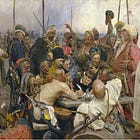A Better Analogy?
The War in Ukraine (2014-2023)
Pace Ibn Khaldun, analogies prove nothing. They can, however, provide perspective, and this is what I hope to do with the following comparison.
The phase of the war in Ukraine that began with the Russian invasion of 24 February 2022 looks a lot like the Korean War. First there was a surprise attack and the rapid capture of a lot of territory. Then there was a big withdrawal, as well as several smaller ones. Finally, there was a sustained period of position warfare, punctuated, at times, by fierce fights for small pieces of ground.
Both the current war in Ukraine and the Korean War could be characterized as “civil wars.” That is, each of the combatant coalitions included a large number of local people who, within living memory, had been compatriots. At the same time, both conflicts might also be described as “lopsided proxy wars.” That is, while the great powers on each side provided the funding that kept the fighters fighting, only one great power in each conflict put substantial numbers of its own troops into the field.1
In the Korean War, many American leaders thought that the Communist invasion of South Korea was a distraction, a gambit designed to reduce the size and strength of American forces in Europe. Thus, substantial forces that might otherwise have been sent to Asia were used to bolster the defenses of NATO. In much the same way, Russian leaders have devoted but a fraction of the forces available to them to the war in Ukraine, keeping the lion’s share in readiness for other contingencies.
For Further Reading:
To Share, Subscribe, or Support:
Soviet pilots flew combat aircraft in the Korean War. However, Soviet authorities took great pains to hide this fact and, in particular, to preserve their pilots from missions that might result in their capture.






Quibble, while I agree that Russia has more forces that they could theoretically use in Ukraine, one of the big problems they face is the amount of their forces that are totally unsuited to operating in Ukraine. For example, they could shutdown air defenses across most of Russia to send the operators to Ukraine, but they probably don't want to do that. Similarly, they could transfer all the personnel of the Strategic Rocket Forces to Ukraine, but I doubt they would want to do that either.
While there is an obvious mismatch in defense spending and manpower, Russia's problem is that a lot of its spending is committed to things that are important to its great/superpower pretensions but are useless against Ukraine. The Russian navy is largely useless. Aside from the dwindling Black Sea fleet and the missile corvettes in the Caspian, the surface warships and submarines of the Baltic, Pacific, and Northern fleets contribute virtually nothing to the fight against Ukraine. The SSBNs do nothing. The Strategic Rocket forces do nothing. The extensive air defense system inherited from the USSR does little, although it does help in that there are lots of S300 missiles both for SAM use and as second-rate surface to surface missiles.